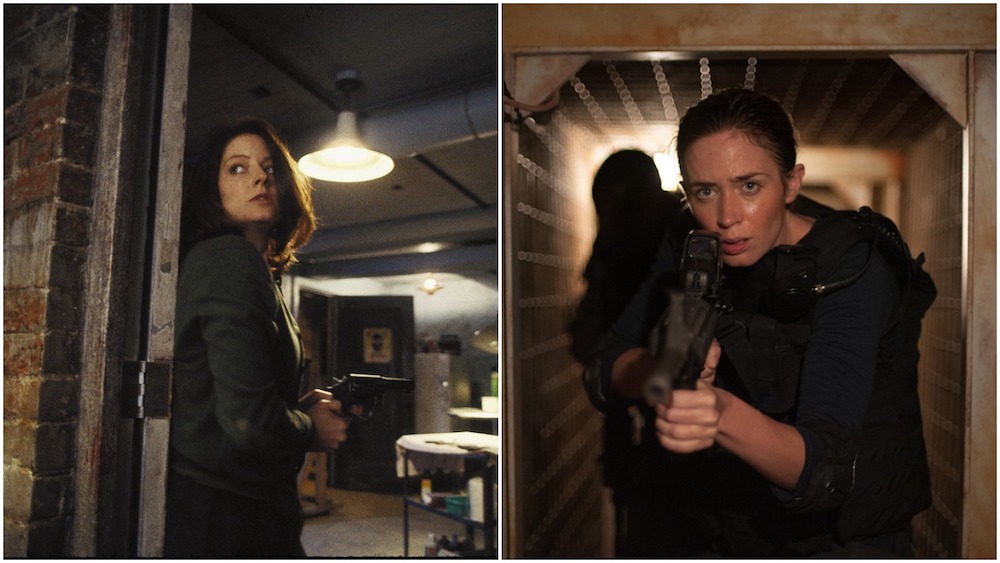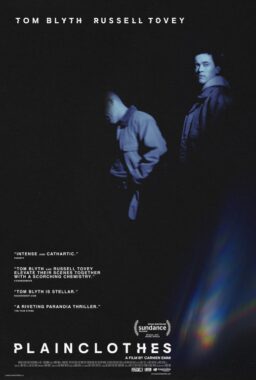A female investigator has two duplicitous mentors: One, a secretive supervisor; the other, a criminal who’s a necessary ally. Each uses her to his own ends. She’s a woman of integrity, not to be underestimated, but in trying to find the light, she finds more darkness.
Sound familiar? Although released 24 years apart, this setup applies to both the procedural thriller “The Silence of the Lambs” (1991) and the drug-war drama “Sicario” (2015).
“Sicario,” Oscar-nominated for Best Sound Editing, Best Original Score, and Roger Deakins’ cinematography, has a jarring unpredictability and brutality that evokes “The Silence of the Lambs,” a rare Oscar winner across five top categories: Best Picture, Best Director, Best Actor, Best Actress, and Best Adapted Screenplay. But the films mirror each other most in character dynamics. Emily Blunt’s FBI agent Kate Macer in “Sicario” and her relationship with the two male leads (Josh Brolin and Benicio Del Toro) reminds me of Jodie Foster’s FBI cadet Clarice Starling and her tango in “Silence of the Lambs” with mentor Jack Crawford (Scott Glenn) and serial killer Dr. Hannibal Lecter (Anthony Hopkins).
When “Sicario” was released, some critics noted how Kate was another woman in law enforcement onscreen, such as Clarice and Jessica Chastain’s Maya from Kathryn Bigelow’s “Zero Dark Thirty.” The seasoned Kate has more firearms prowess and physical confidence, but like Clarice, she barely has a home life, and her only real friend on the force (Daniel Kaluuya) fills a function similar to that of Clarice’s roommate and confidant (Kasi Lemmons). Men in both films size up these women, stare them down, and dare them to keep pace. More importantly, each is sent down the rabbit hole because of her brains, passion, and ambition, all to cement the films’ themes. Both women physically venture into murky spaces, but the characters who hold the most sway over them literally keep them in the dark.

In “The Silence of the Lambs,” which Ted Tally adapted from Thomas Harris’s bestselling novel, male FBI cadets dwarf Clarice in the elevator right before Crawford sends her to talk to Lecter, a serial killer imprisoned in a mental hospital for the criminally insane that cinematographer Tak Fujimoto renders like a dungeon: a dusky hallway, inmates hidden in shadow, cell walls of gray brick. Crawford wants to pick Lecter’s brain to help solve another grisly series of killings, but he doesn’t tell Clarice that. He knows Lecter, an erudite former psychiatrist, would detect an agenda and shut her down. Better that Lecter find her intriguing—which he does, after the sanitarium director first hits on Clarice twice within seconds.
Lecter first calls Clarice a rube with a good bag and cheap shoes. He unnerves her, but she fires back: “You see a lot, Doctor. But are you strong enough to point that high-powered perception at yourself?”
Clarice is clever enough to decipher his anagrams, wriggling under the stuck door of a storage unit after dark with a flashlight in search of clues. Lecter grows fascinated with her, but he also loves analyzing her, all the while manipulating her and the FBI for his own goal: escape.
Likewise, in “Sicario,” directed by Denis Villeneuve, Matt Graver (Brolin), head of a multiagency drug task force, and Alejandro (Del Toro), the other party in this pas de trio, tell Kate only what she needs to know. “Nothing will make sense to your American ears,” Alejandro says, sounding dismissive and honest at the same time.
Kate lobbies to be on the task force after her FBI SWAT team raids a suburban drug house. Cinematographer Roger Deakins shoots the firefight under the sparse light of covered windows and secrecy, giving way to dozens of bodies sealed in the walls and a bomb on site that kills local police officers. Kate is determined to find who’s responsible, and Matt smells an opportunity. Before signing her on, he asks less about her qualifications than whether she’s married or has children—in other words, whether there’s anyone who might miss her. She’s soon accompanying him and Alejandro to a bus depot at night and a grungy base with interrogation rooms.
Matt turns out to be a spook who needs Kate for a purpose that he plays close to the vest. In the film, the CIA can’t operate within the United States unless it assists another agency, and he wants Kate to provide that cover. Alejandro wants the freedom this arrangement allows, but like Lecter, he has hidden motives. A former Colombian prosecutor, Alejandro works with the CIA, a competing cartel, anyone who might lead him to the killers of his wife and daughter.

Crime stories in particular love enigmatic characters who use innocents to their advantage, a la Ethan Hawke’s rookie in Antoine Fuqua’s “Training Day” (2001). Both “Silence of the Lambs” and “Sicario” hit that motif hard. Clarice’s childhood memory of slaughtered spring lambs and the one she couldn’t save reveals her inner drive. No one calls Kate a lamb, but it’s implied heavily. “You are not a wolf, and this is a land of wolves now,” Alejandro tells her.
Both women also put up with condescension, such as when Crawford tells a sheriff how they shouldn’t talk in front of a woman, a rapport-building move that Clarice rightfully tells him matters. Alejandro mixes belittlement and sympathy when he tells Kate, “You look like a little girl when you’re scared.”
Kate is shot and more broken emotionally by her story’s end, but each film’s finale effectively leaves these women speechless. Clarice summons reservoirs of courage to face serial killer Buffalo Bill alone in his underground lair, at one point in pitch blackness. Kate probes a secret tunnel under the U.S.-Mexico border lit by muzzle flashes and caged bulbs on wires.
But once each woman emerges from these catacombs, the films twist the idea of victory. Lecter, on the loose, phones Clarice after she graduates from the FBI, leaving her dumbstruck holding the receiver. In “Sicario,” Alejandro forces Kate at gunpoint to sign documents legitimizing the CIA’s operation. Kate is “passive against her own will,” as “Sicario” screenwriter Taylor Sheridan described her: angry yet impotent. She can’t bring herself to shoot Alejandro as he leaves—a decision Villeneuve saw as hopeful because she retains her values, but that Sheridan views differently. “I drag her through hell,” Sheridan said, “and betray her in the end.”
Blunt told the Los Angeles Times there was “initial pressure” to make her character a man to bump up the film’s budget, which would “completely alter the dynamic of the piece. The interesting fact for the audience is that she’s a woman.”
This casting decision also adds subtext. These films are about monsters and evil and the compromises involved in battling them. They’re also far more enamored with the killers than the investigators. (Each film’s sequel focuses on the man who got away.) Clarice and Kate are relatable and admirable, but they’re also undermined and powerless against systems and games they’re not fully invited to join. Way before they plunge into dark places, they navigate mazes of deception. I like to imagine how enlightened they’d be once they emerge.











